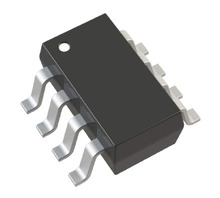Manufacturer Part Number
AD5660BRJZ-2500RL7
Manufacturer
Analog Devices
Introduction
The AD5660BRJZ-2500RL7 is part of the nanoDAC® series and is a 16-bit Digital to Analog Converter (DAC) designed for precise data acquisition tasks.
Product Features and Performance
16-bit resolution
Single D/A converter
Settling Time: 10µs
Output Type: Voltage - Buffered
Data Interface: SPI, DSP
Internal reference type
Supports voltage supply of 5V for both analog and digital
Operating Temperature range: -40°C to 105°C
Mounting Type: Surface Mount
Packaged in an SOT-23-8 small form factor
Product Advantages
High-resolution output enhances precision in applications.
Fast settling time allows quick response for control systems.
Internal reference reduces additional external component requirement.
Compatible with popular communication protocols (SPI, DSP).
Capable of operation across wide temperature ranges, enhancing environmental endurance.
Key Technical Parameters
Number of Bits: 16
Settling Time: 10µs
Output Type: Voltage - Buffered
Voltage - Supply, Analog: 5V
Voltage - Supply, Digital: 5V
Operating Temperature: -40°C ~ 105°C
INL/DNL (LSB): ±16 (Max), ±1 (Max)
Architecture: String DAC
Quality and Safety Features
Robust performance from -40°C to 105°C ensures reliability in extreme conditions.
Surface mount design for secure and reliable PCB mounting.
Compatibility
Compatible with systems utilizing SPI and DSP data interfaces.
Application Areas
Instrumentation
Automatic test equipment
Data acquisition systems
Digital signal processing
Product Lifecycle
The AD5660BRJZ-2500RL7 is currently active with no indication of discontinuation. Analog Devices typically supports product availability and may offer replacement or upgrades when necessary.
Several Key Reasons to Choose This Product
High resolution (16-bit) for demanding applications requiring precise output.
Rapid settling time to facilitate faster system responses.
Internal reference minimizes design complexity.
Broad compatibility with SPI and DSP ensures ease of integration into existing systems.
Operational stability across a wide temperature range (-40°C to 105°C) ensures reliability in varying environments.



 AD5660CRJ-1ADI (Analog Devices, Inc.)
AD5660CRJ-1ADI (Analog Devices, Inc.) AD5660BRJZ-3 500RL7
AD5660BRJZ-3 500RL7